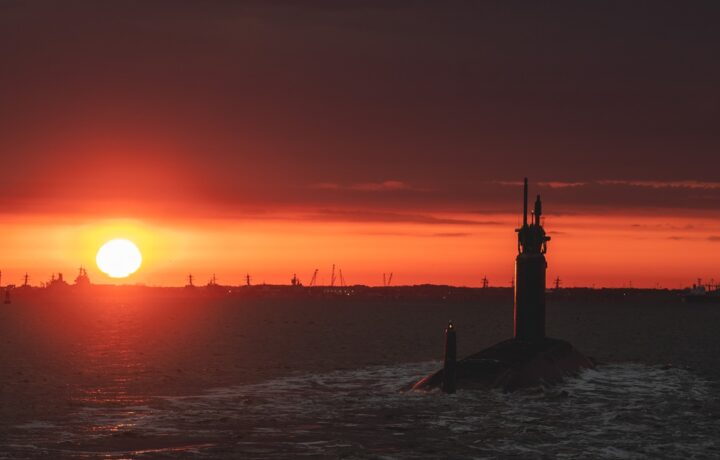The USS New Jersey has been in the news of late – but actually it involves two completely different US Navy vessels. The first is the now retired World War II Iowa-class battleship USS New Jersey (BB-62), which this month left her home of more than two decades on the Camden waterfront across from Philadelphia for a much needed repair to her hull.
The other vessel named for the Garden State is the Block IV Virginia-class attack submarine PCU (Pre-Commissioning Unit) New Jersey (SSN-796), which completed her initial sea trials. The boat spent several days at sea to test various systems and components, Huntington Ingalls Industries’ Newport News Shipbuilding division announced earlier this month.
Testing reportedly included submerging the submarine for the first time and conducting high-speed maneuvers while on the surface and submerged. NNS teams will continue the testing program ahead of delivering the boat to the U.S. Navy.
“Taking New Jersey out for the first time is a significant milestone and the first major test of the submarine’s capabilities at sea,” said Jason Ward, NNS vice president of Virginia-class submarine construction. “Both New Jersey and her crew performed exceptionally well. This was truly a team effort between shipbuilders, thousands of suppliers around the country and the crew. We look forward to delivering New Jersey to the Navy soon so it can begin its service to our nation.”
The nuclear-powered fast attack submarine is the twenty-third Virginia-class boat to be built and she was christened in November 2021. She is also the eleventh to be delivered by NNS. The future USS New Jersey is currently on track to be commissioned on September 14, 2024.
Video: New Jersey (SSN-796) Sea Trials
The Third USS New Jersey – Second of the Virginia-class
SSN 796 will be just the third U.S. Navy vessel to be named for New Jersey – and in an interesting twist, she is also the second from a Virginia-class. That is because the former USS New Jersey (BB-16) was the fourth of five Virginia-class battleships.
She was laid down at the Fore River Shipbuilding Company in Quincy, Massachusetts, in May 1902, launched in November 1904, and commissioned into the fleet in May 1906. The ship was armed with an offensive battery of four 12-inch (305 mm) guns and eight 8-inch (203 mm) guns, and she was capable of a top speed of 19 knots (35 km/h; 22 mph).
She joined the famous Great White Fleet in its circumnavigation of the globe, and during the First World War served as a training ship while later was tasked with transporting U.S. servicemen back from Europe. BB-16 was sunk during bombing tests in 1923.
The second USS New Jersey (BB-62) was spared a similar fate, and was preserved as a museum ship, in part to ensure that she and her three Iowa-class battleships could be returned to service if needed.
Known as the “Big J” or “Black Dragon,” USS New Jersey (BB-62) has the notable distinction of being one of the most decorated battleships to have served in the U.S. Navy, while she was also among the largest warships ever built. The second of the Iowa-class, like her sister vessels, she was designed as a “fast battleship” that could travel with a carrier force and take the fight to the Japanese during World War II.
Recalled to service during both the Korean and Vietnam Wars, and then again in the 1980s,BB-62 was decommissioned a final time in February 1991. During her decade’s long career, the battleship earned nine battle stars for her World War II service, four for the Korean War, three for the Vietnam War, and three for action in Lebanon and the Persian Gulf region.
Block IV Submarine
In addition to being the first attack submarine designed with a modification for gender integration, SSN-796 is one of the ten Block IV submarines of the Virginia-class. She displaces 7,835 tons, with a hull length of 377 feet and a diameter of 34 feet, and can attain speeds of 25 knots with the power from its nuclear reactor. Each of the Block IV boats can dive to more than 800 feet.
The submarines feature Mark 48 advanced capability torpedoes and Tomahawk cruise missiles. The boats are equipped with the Virginia Payload Module, an 84-foot-long, mid-ship section that has four large-diameter, vertical launch tubes for keeping and launching more Tomahawks and other payloads.
The Block IV boats incorporate design changes that were focused on reduced total ownership cost. By making these smaller-scale design changes to increase the component-level lifecycle of the submarine, the U.S. Navy was able to increase the periodicity between depot maintenance availabilities and increase the number of deployments. The main improvement of the Block IV over the preceding Block III is the reduction of major maintenance periods from four to three, increasing each boat’s total lifetime deployments by one.
The Virginia-class boats remain the U.S. Navy’s primary attack submarine for land, surface, and anti-submarine attack missions, and its armaments include cruise missiles and torpedoes. Each is also equipped with a large lock-in/lock-out chambers that allow Navy SEALs to operate from the boat, while there are future plans for it to be used to launch underwater drones. Instead of the traditional periscopes this class of submarines utilizes two photonics masts that host visible and infrared digital cameras atop telescoping arms.




